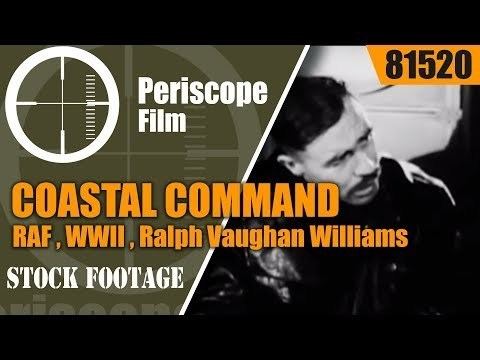Coastal Command (film)
7 /10 1 Votes
Director J.B. Holmes Duration Language English | 6.8/10 IMDb Genre Documentary, War Country UK | |||||||||||||||||||||||||||||||||
 | ||||||||||||||||||||||||||||||||||
Release date 1943 (1943)April 17, 1944 (1944-04-17) (U.S.) Initial release August 27, 1943 (Portugal) Cast Charles Norman Lewis, Roger Hunter Similar movies Wherever She Goes (1951), There Goes the Bride (1932), The Iron Duke (1934), Turn of the Tide (1935), The Hound of the Baskervilles (1932) | ||||||||||||||||||||||||||||||||||
coastal command documentary by j b holmes 1943 ost by ralph v williams
Coastal Command is a 1943 British film made by the Crown Film Unit for the Ministry of Information. The film, distributed by RKO, dramatised the work of RAF Coastal Command.
Contents
- coastal command documentary by j b holmes 1943 ost by ralph v williams
- Coastal command raf wwii ralph vaughan williams 81520
- Plot
- Cast
- Production
- Reviews
- The coastal command american version of british wwii documentary 81522
- References
Coastal Command is a documentary-style account of the Short Sunderland and Consolidated PBY Catalina flying boats during the Battle of the Atlantic. The film includes real footage of attacks on a major enemy ship by Hudson and Halifax bombers based in Iceland.
Coastal command raf wwii ralph vaughan williams 81520
Plot
In 1942, a Sunderland flying boat with Pilot Roger Hunter and Flight Sergeant Charles Norman Lewis as crew, set out on a patrol, flying out of their Scotland air base.
During the routine sea patrol, in which a convoy is spotted, the crew encounters and bombs a German U-boat.
The Sunderland's crew returns to England, mission accomplished, but with a wounded crew member aboard, who is in stable condition. After a visit to the hospital, the Sunderland crew is informed they will be re-deployed to West Africa, to begin a new mission.
Cast
Production
Coastal Command was made under the supervision of Ian Dalrymple, with the full cooperation of the Royal Air Force and the Royal Navy in the Second world War. The participants in the film were active RAF officers, NCOs and aircrew, and RN officers. The film featured pilot Roger Hunter and Flight Sergeant Charles Norman Lewis. On 25 August 1942, Lewis was killed on a flight that Prince George, Duke of Kent was undertaking as a morale-boosting mission to Iceland.
Filming for Coastal Command took place at Pinewood Studios, Iver Heath, Buckinghamshire where an RAF Operations Room set was constructed for the Ministry of Information. Location photography also took place at RAF Bowmore and RAF Port Ellen, Glenegedale, Isle of Islay, Argyll and Bute, Scotland, where Short Sunderland units were operating.
Coastal Command is notable for its score by Ralph Vaughan Williams.
Reviews
The performances in Coastal Command were generally well received as they were real-life depictions of a coastal command unit in wartime. After the release of Coastal Command in the United States on 18 April 1944, Bosley Crowther, film reviewer for The New York Times wrote that it suffered in comparison with the similar Memphis Belle documentary. He did write, however, that: "Many of the individual glimpses in this film are intriguing to the eye, and the whole conveys an academic notion of the personal and organizational problems of the Coastal Command. But the obvious studio-staging of much of the action in which personnel is involved and the scattered arrangement of continuity drain the film of sharp immediacy and drive. Because it jumps its scenes from one plane to another, from shore to plane — and even a few times to the Nazi ship—without adequate definition, the spectator is forced to an objective point of view. A sense of artificial construction is plainly inevitable. Thus suspense and excitement are lacking. The mood becomes fitful and blasé."
The coastal command american version of british wwii documentary 81522
References
Coastal Command (film) WikipediaCoastal Command (film) IMDb
